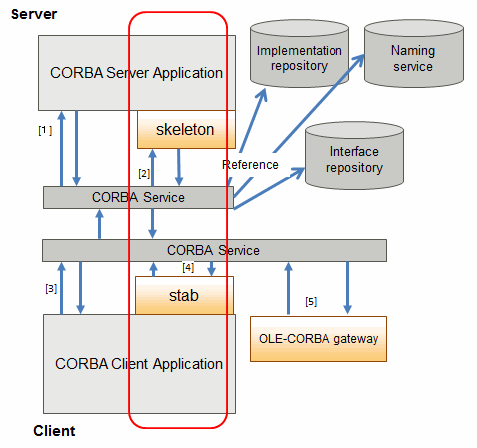CORBA is a specification of the object-oriented technology provided by OMG (Object Management Group: a nonprofit organization established with the aim of the standardization and the spread of object-oriented technology in 1989). The following functions are being offered as CORBA specifications.
The mechanism that generates the stub and the skeleton from IDL(Interface Definition Language). Stub and skeleton are the communication library between server/application.
API used for communication between client / server application
Protocol for communication between client/server application that operates on different kinds of machine (IIOP :Internet Inter-ORB Protocol).
Fujitsu is providing the distributed communication base and service in accordance with CORBA in Interstage Application Server. In Interstage Studio, the CORBA application means the application made by using Interstage Application Server. Moreover, both the CORBA server application and the CORBA client application can be made in the Interstage Studio workbench where the COBOL plug-in is built in.
CORBA application operation form
The figure below shows the operation form of the CORBA application. The operation form supported by the COBOL plug-in is shown with a red frame.

The server application can be roughly divided into the following two types according to the method of disclosing interface information to the client.
"1" Dynamic skeleton interface
"2" Static skeleton interface
The client application can be roughly divided into the following three types according to the method of calling the server application.
"3" Dynamic Invocation Interface
"4" Static Invocation Interface
"5" OLE-CORBA gateway
Feature and range of support for CORBA application
The feature of each CORBA application and the range of support in the COBOL plug-in are shown below.
Application type | Description | Support | |
|---|---|---|---|
Server | Client | ||
Dynamic interface "1""3" | The stub file and the skeleton file are unnecessary, information is taken out of the interface repository, and the parameter is assembled in the program to call the method of the server. | not supported | not supported |
Static interface "2""4" | Links the stub and the skeleton file made from the IDL file into the application. The stub and the skeleton convert the data used between the server and the client from CORBA communications infrastructure protocol (IIOP) into each language type. | support(*1) | support(*2) |
OLE-CORBA gateway | Functions of the server application are called by the OLE access of the Windows system. | N/A | N/A |
*1: The server application is made in object-oriented COBOL language.
*2: The client application is made in object-oriented COBOL language or COBOL language.
Because the Dynamic Interface dynamically assembles the interface of the server application, it's not always necessary to change the program when the interface has changed slightly. From this respect, maintainability is good.
Because the Static Interface accesses repository information on the server less frequent than the Dynamic Interface, the static interface has excellent performance.
Because the OLE-CORBA gateway has the processing internally similar to the dynamic interface, the performance is the same as the dynamic interface. Also, very little coding is required.